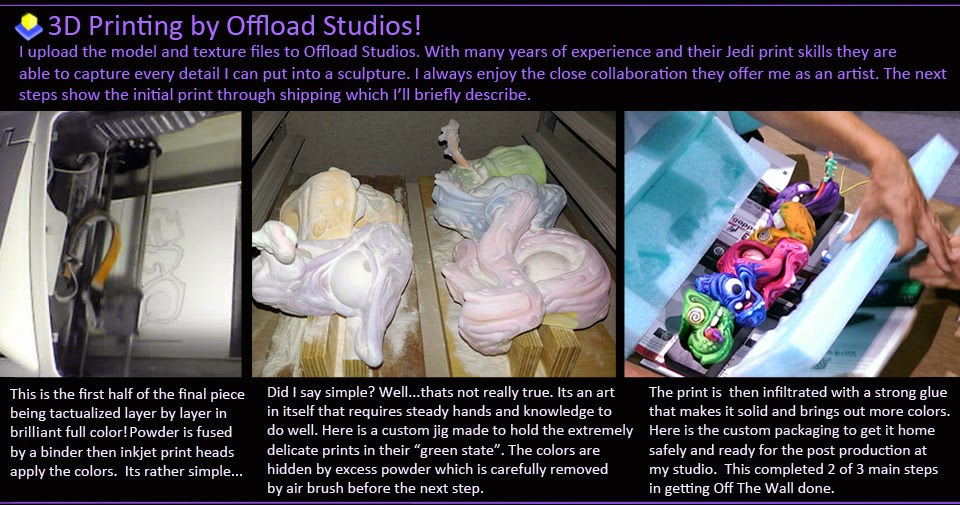The newfound ability to bring physical reality to complex, full colour digital creations – and its ever more accessible costs – is giving modern artists previously unimaginable means of expression. However making a 3D printed sculpture is not as easy as just pressing “print”. Getting digital creations to literally come “off-the-wall” takes a lot of work
There is a lengthy and highly specialized process involved, where accurate planning can improve and simplify each successive step. Digital sculptor Dennis Harroun ran through and illustrated each one of these steps for his latest work Off the Wall, “tactualized” by Offload Studios, a professional 3D printing service based in Vancouver (CA) for the entertainment industry.
Harroun’s work is off-the-wall in more ways than one: it is a combination of crazy off the wall looking creatures that use 3D printing to effectively come off a two dimensional base wooden board. The creative process begins – as is most often the case – with a 2D sketch (so, if you can’t draw, don’t think 3D printing can magically make you an artist). In Harroun’s case the original sketch was made with pencils and markers but it already had features that made it a perfect fit for ‘3dimensionalizing.’
The next step consisted of creating a base mesh while already keeping in mind the 3D printer’s capabilities: the entire mesh was developed as multiple objects so as to save memory and make the work larger than a single print would allow. Each part of the sculpture was then hollowed out by creating a smaller mesh inside of it, while keeping in mind the material’s strength (in this case gypsum) to decide how thick the walls should be, while saving as much material (and money) as possible.
A “boolean” trick developed by Offload Studios lets Harroun work easily around the more complex boolean operations while dissecting the print into two separate sections for maximum print size. The final render is then planned out to help define the post-production work, then the 3D printing begins.
For its “tactualization” process, Offload studios uses 3D Systems’ Projet x60 technology (an evolution of the original Zcorp tech). The “green state” prints, held together by the colour binder, print delicate parts that can be cleaned of excess powder and infiltrated with strong glue. Then it’s time for post production, another crucial phase where the artist can truly express his or her talent.
Harroun sanded the piece, being very careful not to go through the colour and then, using an airbrush, he applied multiple clear coats, making the vibrant colours show through. In the final step the pieces are applied to the wooden base. All in all the process is not exactly easy: traditional artists need not worry, 3D printing is not about to turn everyone into a creative genius. What it will do is give modern artists a way to experiment with new ways to express their talents. Isn’t that what art is about?





